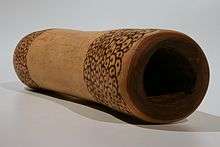Australian Aboriginal artefacts
Australian Aboriginal artefacts include a variety of cultural artefacts used by Aboriginal Australians for occupations such as hunting, warfare, food preparation and making music or art. These include boomerangs, spears, shields, dillybags and many other items. Some artefacts have ceremonial uses, and are regarded as ritual or secret sacred objects.

Purposes
Many Aboriginal artefacts were multi-purpose, for example boomerangs could be used:
- as hunting or fighting weapons;[1]
- for digging;
- as cutting knives;[2]
- for making fire by friction;[3] and
- as percussion instruments for making music.[4]
Weapons
Aboriginal people used several different types of weapons including shields, spears (also known as hielaman), Spear-throwers, boomerangs and clubs. Peoples from different regions used different weapons.[5] Some peoples, for example, would fight with boomerangs and shields, whereas in another region they would fight with clubs. Not all weapons were for warfare; many were used primarily for hunting game.
Weapons were of different styles in different areas. For example, a shield from Central Australia is very different from a shield from North Queensland.[6]
Everyday items
Everyday items include digging sticks, stone axes, coolamons and dilly bags. These items were mainly used in food-gathering, but were sometimes also used on ceremonial occasions.
Sacred items
Artefacts sometimes regarded as sacred items and/or used in ceremonies include bullroarers, didgeridoos and carved boards called churinga.
Art
Most Aboriginal art is not considered artefact, but often the designs in Aboriginal art are similar designs to those originally on sacred artefacts.[7][8]
References
- "Aboriginal Weapons". www.mbantua.com.au. Retrieved 1 April 2018.
- "Hunting Boomerang: a Weapon of Choice - Australian Museum". australianmuseum.net.au. Retrieved 1 April 2018.
- "Aboriginal Weapons". www.mbantua.com.au. Retrieved 1 April 2018.
- "Aboriginal Weapons and Tools". austhrutime.com. Retrieved 1 April 2018.
- Aboriginal Australia. Cooper, Carol., National Gallery of Victoria., Australian Gallery Directors' Council. Sydney: Australian Gallery Directors Council. 1981. ISBN 0642896895. OCLC 8487510.CS1 maint: others (link)
- "aboriginal weapons | Aborigines weapons | sell aboriginal weapons". Aboriginal Bark Paintings. 29 August 2017. Retrieved 25 July 2019.
- Bardon, Geoff, 1940- (2004). Papunya : a place made after the story : the beginnings of the Western Desert painting movement. Bardon, James. Carlton, Vic.: Miegunyah Press. ISBN 052285110X. OCLC 59098931.CS1 maint: multiple names: authors list (link)
- "Aboriginal Dot Art | sell Aboriginal Dot Art | meaning dots in Aboriginal Art". Aboriginal Bark Paintings. 28 November 2018. Retrieved 25 July 2019.